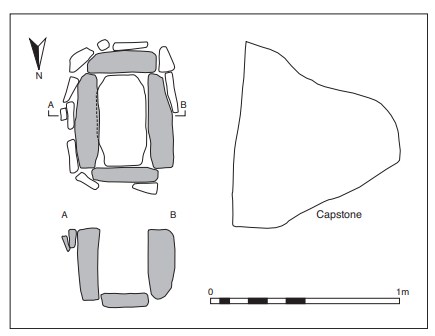County: Donegal Site name: CARRICKBRACK, CO. DONEGAL
Sites and Monuments Record No.: SMR DG069-020SMR DG070-019 Licence number: E1049
Author: BREANDÁN Ó RÍORDÁIN
Site type: Early Bronze Age graves
Period/Dating: —
ITM: E 622491m, N 900756m
Latitude, Longitude (decimal degrees): 54.854139, -7.649750
Introduction
In December 1962 a short cist was uncovered during the removal of stones before ploughing on a farm near Convoy, Co. Donegal. The landowner, Mr Robert J. Allen, on whose land a cist had also been discovered in 1957, suspected that a large flat stone 0.15m below ground level was the capstone of another cist. When he and his workmen lifted the stone a cist was discovered underneath it. The site was subsequently disturbed and part of the cist fill was removed. The fill was examined but did not appear to contain any human remains or artefacts, and it was subsequently deposited on the ground around the cist. The capstone of the cist was not replaced; owing to severe frost, some water lodged in the cist and subsequently froze. The discovery was reported to the NMI on 17 December 1962, and the site was investigated between 8 and 10 January 1963 by Breandán Ó Ríordáin. This report is based on Ó Ríordáin’s report and drawings.
Location (Fig. 3.32)
The cist was in the townland of Carrickbrack, south-east Co. Donegal.50 It lay in a tillage field at an altitude of 30–60m above sea level. Another cist was discovered in the same townland, two fields east of this one, in 1957 and was excavated by Breandán Ó Ríordáin (Ó Ríordáin 1958).51
Description of site
The cist was rectangular in internal plan, with its long axis aligned north/south. Internally it measured 0.54m long by 0.25m wide by 0.36m high (Fig. 3.33). It was composed of four principal slabs set on edge, with one forming each wall. The slabs appear to have been relatively uniform in shape, with the northern end slab being slightly thinner than the others.

They measured 0.5m in maximum length, 0.14m in maximum thickness and 0.38m in maximum height. The main slabs were flanked externally by a packing of smaller stones, which were concentrated on the eastern side of the cist. The maximum dimensions of the packing stones were 0.18m long by 0.1m high by 0.04m wide. The capstone was triangular in outline, measuring 0.97m by 0.88m by 0.15m thick. A single flat, oval slab, measuring 0.48m long by 0.24m wide by 8mm (sic) thick, formed the floor of the cist. The ground was frozen hard and it was not possible for the excavator to continue excavation to find the dimensions of the pit dug to receive the cist. A sample of the stone of the cist was taken for examination and was identified as muscovite-almendine-schist, a metamorphic rock that occurs in County Donegal.
No human remains or artefacts were found in the cist. As the upcast fill of the cist was frozen solid on the ground at the time of the investigation, the excavator asked the landowner to examine it carefully for any human remains or artefacts at a later date. As no further correspondence regarding this matter is on file from the landowner, it is presumed that nothing further was discovered in the upcast material.

Comment
This is the third cist burial to be reported from this townland, the first having been found c. 1896 (Ó Ríordáin and Waddell 1993, 99). A ribbed bowl, the present whereabouts of which is unknown, was found in a small cist. The cist discovered in 1957 contained cremated bone, a tripartite bowl, a flint thumbnail scraper, a flint flake and some quartz chips (Ó Ríordáin 1958).52 The precise location of the first discovery is not known so it is not possible to say whether the three cists form part of a linear cemetery, as there was a distance of 188m between the cists discovered in 1957 and 1962. It is also worth noting the discovery of quartz chips in the 1957 cist. This has been noted elsewhere, e.g. at Tattyreagh (this volume, pp 88–91) and at Ballybrew, Co. Wicklow (Ó Ríordáin and Waddell 1993, 21), while stone chips are recorded from cist 3 at Keenoge, Co. Meath. There is always the possibility that the empty cist excavated in 1962 and described here was the cist first discovered in the late nineteenth century.
PETROLOGY
JOHN S. JACKSON
The specimen submitted for identification is a fragment of muscovite-almendine-schist. This is a metamorphic rock, produced by dynamo-thermal metamorphism and regional metamorphism, and could be anticipated to occur in the pre-Devonian areas of County Donegal, which were subjected to intense metamorphism during the Caledonian orogeny.
50. Parish of Convoy, barony of Raphoe South. SMR DG069-020——. IGR 222544 400765.
51. SMR DG070-019——.
52. 1957:69–73.